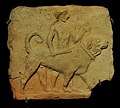Pshdar dog
The Pshdar dog (Sorani Kurdish: سەگی پشدەری) or Kurdish Mastiff is an ancient dog breed landrace native to the Kurdistan region.[1][2] This dogs are often used as livestock guardians against predators.
| Pshdar dog | |||||||||||||||
|---|---|---|---|---|---|---|---|---|---|---|---|---|---|---|---|
 Kurdish Mastiff dog | |||||||||||||||
| Other names | Kurdish Shepherd Dog Peshdar Dog Kurdish dog Kurdish mastiff | ||||||||||||||
| Common nicknames | Pshdar Dog Kurdish mastiff | ||||||||||||||
| Origin | Kurdistan | ||||||||||||||
| |||||||||||||||
| Dog (domestic dog) | |||||||||||||||
It is the oldest dog breed in the Asian region. And one of the oldest in the world. Its history dates back to 6000 years when its ancestors were used by Assyrians and Babylonians as war dogs and for protection against wild animals. It was and is still specially prized for its high stamina while fighting external threats especially wild animals and other dogs. It has a fish-like body, broader at the chest and narrower at the waist which enables it to twist and turn at high speeds irrespective of its huge frame.
The dog is found in Iran in the cities of Bukan, Mahabad, Saqez, Sanandaj, Piranshahr; most of the cities of West Azerbaijan; and parts of Iraqi Kurdistan. The name is most likely derived from the Pshdar region of Iraqi Kurdistan. This breed has been a native breed which formed due to natural selection and a bit human interference.
The coats of Kurdish mastiff can be yellow, white, red, burgundy, blue and black. The breed has loose skin, large dewlaps, and non-cartilaginous (soft and floppy) ears. The breed is longer and stronger than the other Asian mastiffs. Its body length is especially eye-catching since it has a long and slender body resembling the Lion. This breed has a significantly larger amount of endurance comparative to other dog breeds. It also has high body strength and is usually longer than other giant breeds.
Weight and height
.png)
Males weigh between 50 and 92 kilograms (even crossing 100 kg in rare cases), females 45 to 80 kilograms. The height of these dogs at the shoulder is between 75 and 90 centimeters in males and between 70 and 85 in females.
Age
The Kurdish Shepherd dog has a surprisingly longer life span because it formed by natural selection thousands of years ago and is very adaptable and suited to the kurdish climate. If the proper nutrition and home are provided, these dogs live on average 9 to 13 years. If they are used in combat, their expected lifespan is reduced to 6-8 years.
Maintenance
Kurdish dogs need long walks during the day to drain their energy. Besides this they also need other exercises like running and hiking. A large garden or a large courtyard is a must. They are not suited to living in apartments.
Image gallery
 Pshdar dog from Kurdistan
Pshdar dog from Kurdistan Kurdish dog
Kurdish dog Mesopotamian inscription
Mesopotamian inscription Assyrian War Mastiff dog inscription
Assyrian War Mastiff dog inscription
See also
- Kurdistan
- Pshdar District
- dog breeds
- Mesopotamia
References
- "Kurdish Shepherd Dog". Molosserdogs.com. Archived from the original on 13 June 2018. Retrieved 31 July 2018.
- Hole, Frank; Wyllie, Cherra (31 July 2018). "The Oldest Depictions of Canines and a Possible Early Breed of Dog in Iran". Paléorient. 33 (1): 175–185. doi:10.3406/paleo.2007.5213. Retrieved 31 July 2018.
- "History of Dogs". Natural Born Guardians. Retrieved 31 July 2018.
- "ETHNOLOGIE CANINE". Ourkalbousounaki.fr. Retrieved 31 July 2018.
- "History". American Molosser Association. Retrieved 31 July 2018.
- "Dogs & Their Collars in Ancient Mesopotamia". Ancient.eu. Retrieved 31 July 2018.
- "Kurdish Dog". Linkdin. Retrieved October 14, 2019.
- "5 Oppressed Iranian Dog Breeds". Dog Breeds FAQ. 2019-07-12. Retrieved 2019-10-15.
| Wikimedia Commons has media related to Kurdish Mastiff. |